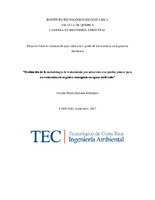Evaluación de la metodología de tratamiento por adsorción con piedra pómez para un contaminante orgánico emergente en aguas residuales
Resumen
In Costa Rica, atenolol, a β-blocker drug, has been identified like an organic emerging compound of high incidence in urban wastewater. Due to its continue discharge, its potential chronic effect on exposed aquatic organisms and the limitation of removal in conventional wastewater treatments, it is of great interest to develop methodologies that contribute to its removal. This research studies the use of pumice stone as an adsorbent to remove atenolol from wastewater. The adsorption capacity of pumice stone was characterized by isotherms and kinetics adsorption, including its dependence on pH, using atenolol solutions of 8 mg/L in batch experiments, with pumice stone of 0,85-1,18 mm granulometry and 4,24 m2/g of superficial area. The adsorption isotherm results were adjusted to Langmuir model, with an adsorption capacity of 0,1131 mg/g in water type II and 0.0439 mg/g in wastewater, both at pH 7,2. The adsorption kinetics of atenolol on pumice stone were adjusted to the pseudo second order model, with an equilibrium time of 4,0 hours. The pH dependence analyses in the adsorption process determined that the best conditions of adsorption are at pH 7. Applying desorption studies, it was found 60% removal after 24 hours of contact time. The results of the adsorption of atenolol onto pumice stone are promising for the concentration levels of atenolol μ/L at the environmental level, so it is recommended continue its study like an alternative line in wastewater treatment plants.
Descripción
Proyecto de Graduación (Licenciatura en Ingeniería Ambiental) Instituto Tecnológico de Costa Rica, Escuela de Química, 2017.


